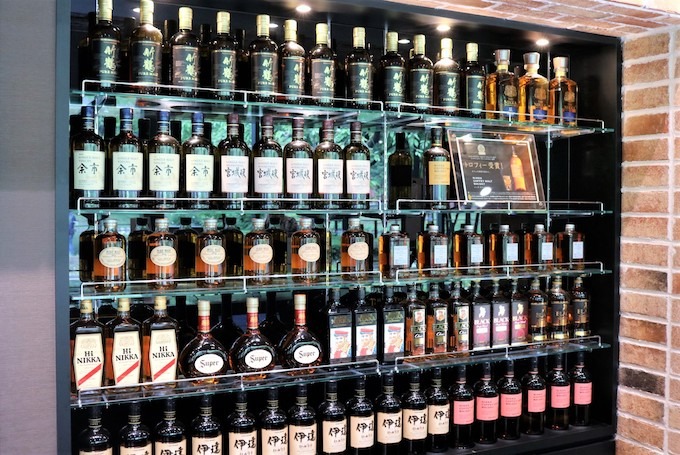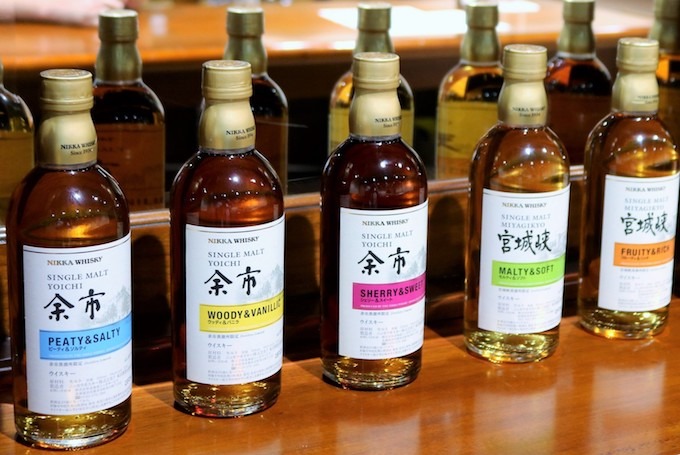Nikka Japanese Whisky
Searching for the secrets to success at Nikka's distilleries
The meteoric rise of Japanese whisky over the past five years was presaged a decade prior when, in 2001, Nikka Whisky won Whisky Magazine's Best of the Best award. Well, sort of. "Then nothing happened," Naoki Tomoyoshi, a key member of Nikka's international team, jokes. There was no overnight transformation—at least not yet. It would 13 more years for Nikka Whisky to reach its tipping point.
In September of 2014, Japanese public broadcaster NHK debuted a docudrama called Massan. It was a monstrous hit, and though it's clearly about Nikka founder Masataka Taketsuru and his wife Rita Cowan (and eventually Nikka—the story hinges more on the couple than the whisky), all of the names were changed in the series. In fact, Nikka had nothing to do with its creation or production, ironically leaving the company ill-prepared for the massive domestic consumer surge to come, in addition to the rising swells of international interest.
In 2015, at the height of the show's popularity, approximately 1.5 million people made a pilgrimage to Nikka's two distilleries. To put that in perspective, approximately 1.7 million people visited a Scotch whisky distillery in 2016—a record for an industry which boasts over 120 distilleries, about half of which are open to the public.

Scottish-Style Whisky with a Japanese Soul
Taketsuru's story began when he was sent to Scotland in 1918 to study whisky production. In addition to enrolling in chemistry at the University of Glasgow, he apprenticed at several distilleries and met his future wife along the way. Taketsuru returned to Japan in 1921, and several years later signed a contract to produce whisky for Kotobukiya—which is now known as Suntory Whisky, producers of Yamazaki and Hibiki. As Suntory's first distiller, Taketsuru earned his nickname "The Father of Japanese Whisky."
Taketsuru and Suntory founder Shinjiro Torii had differing viewpoints, and Taketsuru longed to take charge of his own operation. "He wanted to share his passion," Tomoyoshi says. In 1934, Taketsuru left to begin work at his new Yoichi distillery, with production beginning two years later. Taketsuru was aiming to bring home what he learned in Scotland and put it to use as authentically as possible while meshing it with Japanese culture. "He wanted to make a Scottish style whisky but with a Japanese soul," Tomoyoshi explains.
In terms of whisky production, this came down to a combination of four factors: a geographical locale and climate that was similar to that of Scotland, the production of a variety of malts, grain whisky distilled on Coffey stills, and artful blending to bring it all together.
Yoichi, remotely located on Japan's northernmost main island of Hokkaido, was chosen as the site of his distillery for its maritime setting, its quality water source and its climate, matching Taketsuru's ideals from Scotland. When he founded his second distillery, Miyagikyo, three decades later, he sought out a different locale. This time, he went with the lush, mountainous environs of the Miyagi Prefecture outside of Sendai. "It's a totally different location, different terroir," Tomoyoshi says.
The two distilleries also differ in their means of production. While Miyagikyo uses indirect steam distillation, Yoichi follows the old-school methodology of direct coal-fire distillation, a practice lost in much of the modern whisky world. Various other production matters are handled in different fashions, and the stills at each distillery also have different sizes and shapes. The result is that Miyagikyo has a lighter and more floral profile, emphasizing the influence of sherry casks, while Yoichi showcases a heavier spirit, combining the influence of peat with briny, oceanic qualities.
The Importance of the Blend
If modern distillation is a science, blending remains an intuitive art in many ways, and it's the blenders who are ultimately responsible for achieving both quality and consistency. That's "where it all starts," Tomoyoshi says. "That's why for Nikka it's not the master distiller, it's the blender. Even with the single malts."
The two distilleries can produce dozens of varieties of malt whisky. This is performed by using different yeasts and fermentation times, and different levels of peat, while tweaking the specifics of distillation and using a variety of cask types for maturation. All of this is in addition to the range of grain whiskies produced on Miyagikyo's Coffey stills.
Together, it's akin to housing an entire industry under the roof of a single company. "We have to make all of our own styles," Tomoyoshi says. For instance, Yoichi single malt may actually include 20 separate malt components, all distilled at Yoichi, precisely pieced together to match the desired flavor profile. This is opposed to the Scotch world, where even at the turn of the 20th century, whisky could be sourced from over 150 separate distilleries.
Tomoyoshi estimates that Nikka has approximately 3,000 different batches of whisky stored in its warehouses, an unfathomable vast inventory of shades and hues from which the blender can create his masterpiece.
Where Has All the Japanese Whisky Gone?
The cruel reality of our love affair with Japanese whisky is that as soon as most of us discovered it, many of the finest expressions began disappearing due to supply shortages. Nikka was forced to either discontinue or severely allocate older products, replacing them with non-age statement (NAS) versions of both its single malts, Yoichi and Miyagikyo, as well as its blend, Taketsuru Pure Malt, while adding the highly acclaimed Coffey Grain and Coffey Malt whiskies to its portfolio.
Rest assured though that more whisky will become available in due time, and that Nikka is doing things the right way to get that job done. Even as business is booming at a pace they're hustling to keep up with, there's still a quiet calm in the air at both of Nikka's distilleries. The whisky will get made and eventually come of age, but they won't be rushed or compromised along the way. They won't settle for anything less, and neither should we.
Jake Emen is a food, drink and travel journalist living in San Diego. Follow his adventures on Twitter at @ManTalkFood.


